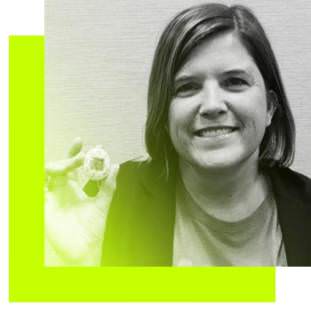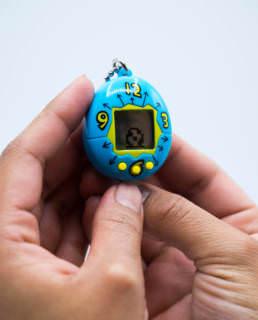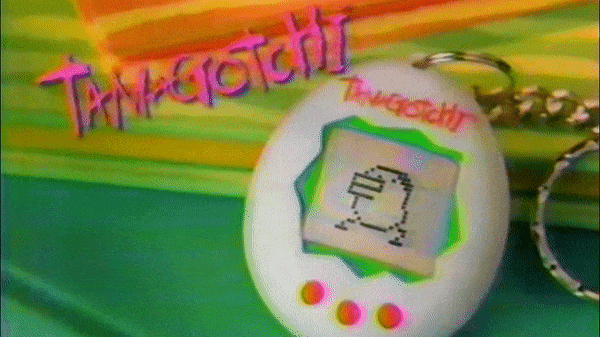
Long before there were smartphones and apps to entertain kids, there was the Tamagotchi, a digital LCD pet housed inside a colorful keychain. Players took to them in droves, nurturing and raising a multitude of characters before the craze died out in the US by the turn of the century.
But ’90s nostalgia is here in full force, and Bandai America is taking advantage of it by bringing the classic toy back to celebrate its 20th anniversary.
“Tamagotchi launched in the US in May of 1997,” Tara Badie, director of brand management and marketing at Bandai America, told AListDaily with all six of the original Tamagotchi styles on display. “We thought it was a good time to bring it back because it’s the 20th anniversary but also because ’90s nostalgia is a huge hit right now with TV shows, products and things like that.”
The devices use the original Japanese launch styles and patterns, with the insides changed with English programming. To celebrate their return, the Tamagotchi website is going back to its original look and style, using logos and branding from the ’90s.
Similar to how Tamagotchi spread through word-of-mouth in the ’90s, Bandai is using social media to spread news of their return in the same way. The company is also working with social influencers to figure out the best way to spread the word.
“We’re just letting people know that it’s out there,” said Badie. “We think word-of-mouth will reach them, because the millennial generation is all over social media. We will be talking on it on Bandai’s social media channels as well as the Tamagotchi channels and website.”
Tamagotchi will hit store shelves on November 5, with pre-sales starting on Tuesday at key retailers including Amazon, Toys “R” Us and Target. Additionally, GameStop, Best Buy and tween clothing store Justice will be offering Tamagotchi. These stores may appeal to a generation that doesn’t remember the ’90s, but their parents may be shopping with them.
“In today’s world, it’s about getting the product into the hands of fans and letting them play. We know we have a good product, so we’re not nervous about giving them to people. At Bandai, we’re known for our good quality, and people know what the product is and its core features. So, we’re sending it out to various folks and we’ll see how they decide to promote it.”
Although the devices differ in looks, each provides owners the chance to raise the same variety of pets. All five of the original characters return, with the addition of one surprise pet that players will have to figure out how to get. Their adult forms are determined by how owners take care of them and the simple gameplay is comprised feeding the Tamagotchi, cleaning up after it poops and giving it affection to make sure it’s happy.
“These are not the ones where we use the latest technology like the newer ones that have launched in Japan over the last couple of years,” Badie explained. “This keeps it very simple and takes it back to what we all remember 20 years ago.”
Badie also discussed the appeal of a 20-year-old toy in the app era.
“There are Tamagotchi apps out there, and they’re going to be relaunching next year,” she said. “But part of what this is all about is that it may be a kid’s only pet. It’s a digital pet that you have to take care of. You might have a lot of stuff on your smartphone, but this is something that you can take with you, take care of, and feel like it’s a pet housed inside the device.”
Although Badie admits that toy companies such as Bandai face a great challenge from apps, she believes that having a physical offline device may be a great benefit.
“I think parents would like to get their kids away from screens so that they can sit down and perhaps play it with their parents,” said Badie. “I think that toys use more of your imagination, and sometimes apps don’t allow you to do that. This is like a house for your pet that you’re taking with you, so it’s not as cold as a smartphone app. You’re holding [a Tamagotchi], taking care of it and protecting it from everything that’s going on.”
As for the pre-app generation of kids who weren’t around in the ’90s, Badie believes that Tamagotchi can be something that can be passed down, possibly setting up a new sense of nostalgia down the road in another decade or two.
“Our core focus is on the millennials generation first, but the overall play pattern is core to all ages,” Badie said. “Everyone likes to take care of a pet, and this is a way to have one. We think that millennials will be very excited to have it back and they’ll share it with the younger generation. Some of them have kids or younger siblings and relatives that they can introduce to the Tamagotchi world.”
 Badie also explained that the core principles of the Tamagotchi—nurturing and taking care of your pet—is what gives the brand its strength after 20 years.
Badie also explained that the core principles of the Tamagotchi—nurturing and taking care of your pet—is what gives the brand its strength after 20 years.
“When we launched, there wasn’t the world of digital as there is today, and we were the first to launch [this kind of] brand,” said Badie. “The brand hasn’t been as consistent in the US, but they come out with new versions and styles every six months in Japan, keeping up with the height of technology and communication. This one goes back to the simpler times, which was also done in Japan and did very well because people like to have that nostalgia.”
Badie also suggested that going back to the ‘90s is just the first step in heading to the future. While there was an effort to revive the toy in the US several years ago, it didn’t take off. This time, the Tamagotchi’s return won’t be a one-off event, as Bandai plans a bigger brand strategy for the digital pet, where it incorporates more modern technology.
“We’re taking time to ensure that our next version is based off of what the American kids look for in technology because of the competition from apps. We want to make sure that we combine the best of both of our worlds while keeping to the core of what Tamagotchi is all about.”

